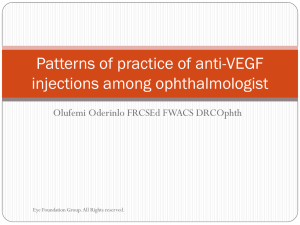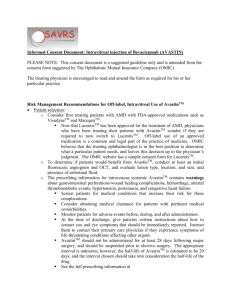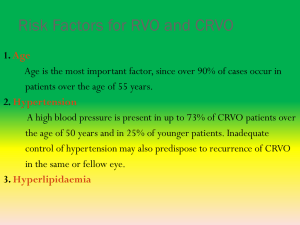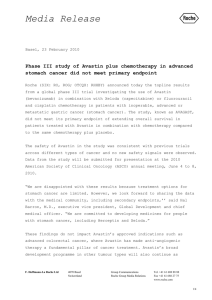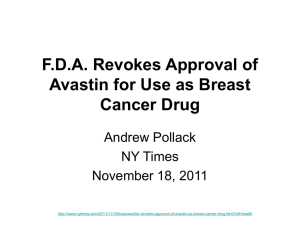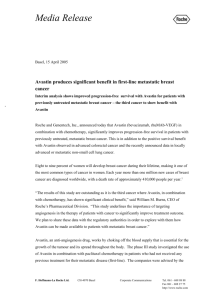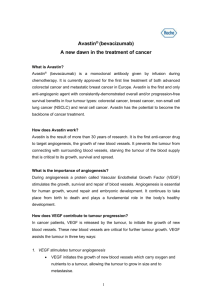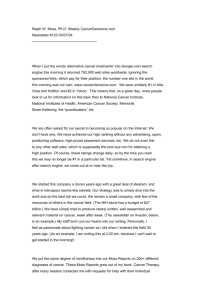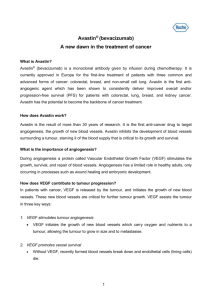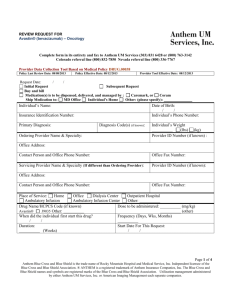avastin - Diabetic Retinopathy
advertisement
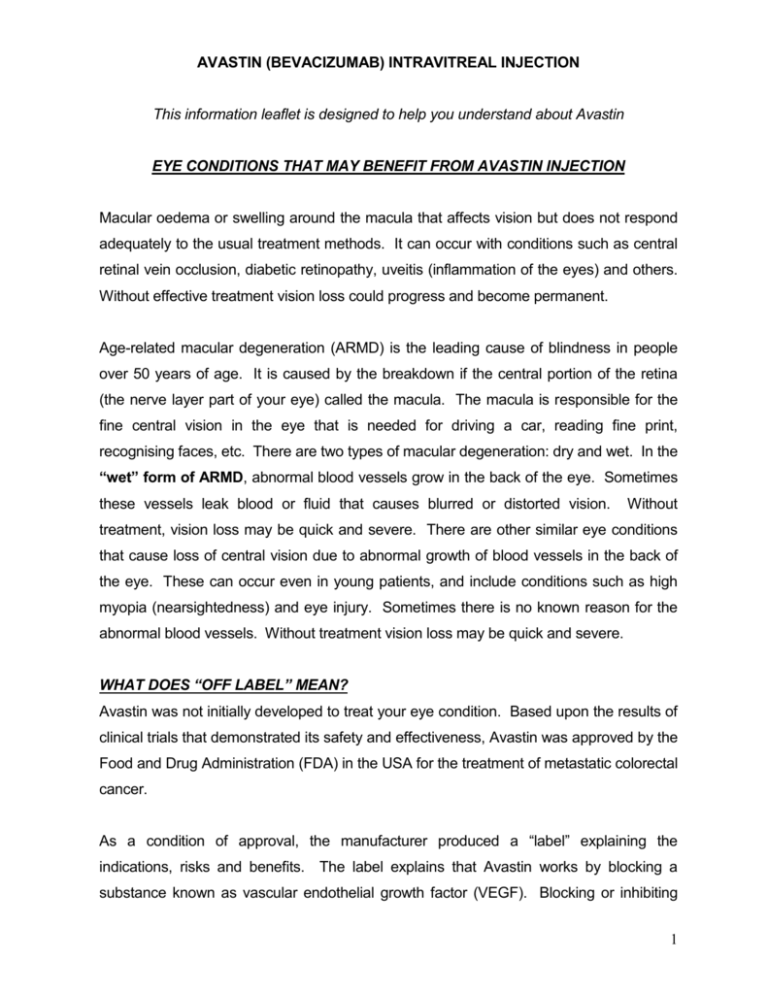
AVASTIN (BEVACIZUMAB) INTRAVITREAL INJECTION This information leaflet is designed to help you understand about Avastin EYE CONDITIONS THAT MAY BENEFIT FROM AVASTIN INJECTION Macular oedema or swelling around the macula that affects vision but does not respond adequately to the usual treatment methods. It can occur with conditions such as central retinal vein occlusion, diabetic retinopathy, uveitis (inflammation of the eyes) and others. Without effective treatment vision loss could progress and become permanent. Age-related macular degeneration (ARMD) is the leading cause of blindness in people over 50 years of age. It is caused by the breakdown if the central portion of the retina (the nerve layer part of your eye) called the macula. The macula is responsible for the fine central vision in the eye that is needed for driving a car, reading fine print, recognising faces, etc. There are two types of macular degeneration: dry and wet. In the “wet” form of ARMD, abnormal blood vessels grow in the back of the eye. Sometimes these vessels leak blood or fluid that causes blurred or distorted vision. Without treatment, vision loss may be quick and severe. There are other similar eye conditions that cause loss of central vision due to abnormal growth of blood vessels in the back of the eye. These can occur even in young patients, and include conditions such as high myopia (nearsightedness) and eye injury. Sometimes there is no known reason for the abnormal blood vessels. Without treatment vision loss may be quick and severe. WHAT DOES “OFF LABEL” MEAN? Avastin was not initially developed to treat your eye condition. Based upon the results of clinical trials that demonstrated its safety and effectiveness, Avastin was approved by the Food and Drug Administration (FDA) in the USA for the treatment of metastatic colorectal cancer. As a condition of approval, the manufacturer produced a “label” explaining the indications, risks and benefits. The label explains that Avastin works by blocking a substance known as vascular endothelial growth factor (VEGF). Blocking or inhibiting 1 VEGF helps prevent further growth of the blood vessels that the cancer needs to continue growing. HOW DOES IT WORK IN THE EYE? Once a drug is approved for any indication, Doctors may use it “off-label” for other purposes if they are well-informed about the product, base its use on firm scientific method and sound medical evidence and maintain records of its use and effects. Ophthalmologists are using Avastin “off-label” to treat eye diseases such as diabetic retinopathy, retinal vein occlusion and wet-aged macular degeneration since research indicates that VEGF is one of the causes for the growth of the abnormal vessels and leakage in these conditions. When injected into your eye Avastin works on inhibiting the growth for abnormal blood vessels in the back of the eye. This drug targets a specific type of protein thought to cause abnormal blood vessels growth. By backing the stimulus it can stop the blood vessels leaking and growing. In some cases it actually causes the blood vessels to regress. WHAT ARE THE LIMITATIONS? Although some patients have regained vision, the medication may not restore vision that has already been lost and may not ultimately prevent further loss of vision caused by the disease. Once a scar forms, we are unable to restore the vision and prevent further vision loss. ARE THERE ALTERNATIVES? You do not have to receive treatment for your condition, although without treatment, these diseases can lead to further vision loss and blindness, sometimes very quickly. Other forms of treatment are available. At present here are two approved treatments for neovascular are-related macular degeneration : photodynamic therapy with a drug called Visudyne (Photodynamic Laser Therapy) and injection into the eye of a drug called Macugen. Although both of these 2 treatments have been proven to slow down the rate of visual loss, most people do not get back better vision. Your doctor will discuss with you the benefits and risks associated with these other choices of treatment. In addition to the approved medications, some Ophthalmologists use intravitreal Kenalog. (Triamcinolone) – a steroid like drug – “off label” to treat eye conditions like yours. Another new drug for intravitreal injection is Lucentis which has proven efficacy like Avastin and it is waiting licensing in Europe. HOW IS THE TREATMENT GIVEN? Avastin is given by an Intravitreal injection. The drug is injected by a retinal specialist into the vitreous gel, which is the jelly-like substance in the back chamber of your eye. This is a sterile procedure that takes place in our theatre suite or special sterile outpatient room. Local anaesthetic drops and injection are used to numb the eye before the procedure and antibiotic drops have to be instilled one week after your treatment. You should experience minimal or no pain after the procedure. This injection may have to be repeated at regular intervals (about every 4-6 weeks), our retinal specialist will tell you how often you will receive the injection and for how long. WHAT ARE THE RISKS AND POSSIBLE COMPLICATIONS? When Avastin is given to patients with metastatic colorectal cancer, some patients experience serious and sometimes life-threatening complications such as gastrointestinal perforations or wound healing complications, haemorrhage, arterial thromboembolic events (such as stroke or heart attack), hypertension, proteinuria (protein in your urine) and congestive heart failure. 3 Patients who experience these complications not only had metastic colon cancer but were also given 400 times the dose you will be given, at more frequent intervals and in a way (through an intravenous infusion) that spreads the drug throughout their bodies. WHAT ARE THE RISKS WHEN IT IS GIVEN TO ME IN THE EYE? Ophthalmologists believe that the risk of these complications mentioned above is very low. Patients receiving Avastin for eye conditions are healthier than the cancer patients and receive a significantly smaller dose (0.05ml), delivered only to the cavity of their eye. While there are no FDA-approved studies about the use of Avastin in the eye that prove it is safe and effective, there are ongoing trials of a similar drug (Lucentis) as well as studies of patients receiving Avastin “off-label”. One study of patients who received Avastin through an intravenous infusion reported only a mild elevation in blood pressure. Another study of patients treated you like you will be with intravitreal Avastin (that is Avastin injected into the eye) did not have these elevations or the other serious problems seen in the patients with cancer. However the benefits and risks of intravitreal Avastin for eye conditions are not fully known. In addition whenever a medication is used in a large number of patients, a small number of coincidental life-threatening problems may occur that have no relationship to the treatment. For example patients with diabetes are already at increased risk for heart attacks and strokes. If one of these patients treated with Avastin suffers a heart attack or stroke, it may be caused by diabetes and not the Avastin treatment. RISKS OF INTRAVITREAL EYE INJECTIONS Serious complications are rare but may lead to severe, permanent loss of vision. The possibility of an eye infection (endophthalmitis). You will receive eye drops with instructions on when to use them to reduce the possibility of this occurring. You should report to us immediately if you have developed a lot of eye pain, blood shot eye and blurred vision (with or without discharge). Contact your consultant’s secretary during office hours (0121 5543801) or Eye casualty at other times (0121 5076780). POSSIBLE RISK OF THE INTRAVITREAL INJECTION INCLUDE: 4 Glaucoma (increased pressure in the eye) Cataract formation (blurred vision due to clouding of the lens of the eye) Retinal detachment (floaters, shadow, reduced vision) Your condition may not get better or may become worse. Any or all of these complications may cause decreased vision and/or have a possibility of causing blindness. Additional procedures may be needed to treat these complications. During the follow up visits or phone calls, you will be checked for possible side effects and the results will be discussed with you. ALLERGIC REACTION Any medication has the potential to cause allergic reactions in a small number of people. Symptoms of an allergic reaction can include a rash, hives, itching, shortness of breath and rarely death. In general, allergic reactions to medicines are more likely to occur in people who have allergies to other drugs, foods or things in the environment such as dust or grass. If you have allergies to other medicines, foods or other things in the environment, or if you have asthma, you should let your doctor know. POST-INJECTION-ADVICE Your eye received injection should have minimal or no discomfort. It may however be slightly bloodshot from the local anaesthetic injection given to you. A clear plastic shield is used to cover your eye temporarily for overnight to avoid you rubbing your eye accidentally. You are advised to use the antibiotic eye drops (G Chloramphenicol) 4 times a day to the injected eye for a week. You will be reviewed in 3 to 4 weeks time in the clinic. You are advised to report to us as soon as possible if you experience any of the adverse event described above: - 0121 554 3801 (asking for individual consultant’s secretary) - 0121 507 6780 (Eye Casualty, City Hospital) 5

